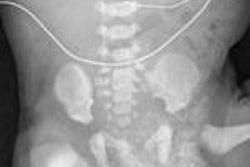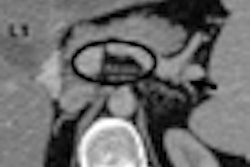Virtual colonoscopy (also known as CT colonography or CTC) is a cost-effective way to screen for colorectal cancer -- provided that individuals with tiny lesions aren't referred for polypectomy, according to the results of a new study from France.
A model based on data from 100,000 participants in a German screening program found scant additional benefit -- but plenty of additional costs -- resulting from polypectomy of diminutive lesions. And there was little evidence of their progression to colorectal cancer. Finally, screening individuals twice (at ages 50 and 60) was found to be far more cost-effective than a single screening, the team found.
"Although the cost-effectiveness of CTC screening has been previously studied, these models have generally assumed that all detected polyps, including diminutive lesions (defined as ≥ 5 mm in size), would be referred to optical colonoscopy for polypectomy," wrote lead investigator Dr. Denis Heresbach, from the University Hospital of Rennes and Centre National de la Recherche Scientifique in Rennes, France, and colleagues.
Their results were published in European Journal of Gastroenterology and Hepatology (July 1, 2009).
Previous studies have proposed surveillance for 6- to 9-mm lesions, the researchers noted, adding that the practice is not currently recommended due to limited clinical evidence, a limitation the current study helps to address. Polyp surveillance is also controversial due to limited understanding of the natural history of polyps.
"Although the prevalence of neoplastic lesions has been determined in the general population only, the frequency of advanced neoplasia according to polyp size has been only established in per lesion analysis, without inclusions of consecutive cases," Heresbach and colleagues wrote.
Screening scenarios
In their model analysis, the authors evaluated the yield of colonoscopic polypectomy for all polyps and compared it to the yield for small (larger than 6 mm) and large (larger than 10 mm) polyps detected on CTC screening studies. CTC-detected polyps smaller than 6 mm were ignored.
"Although this approach was debated in a previous U.S. model, our original contributions rely on base case analysis according to the sex of average-risk participants or range of advanced adenoma (AA) frequencies, and on the inclusion of the cost of follow-up colonoscopies according to current guidelines," the authors noted.
The cost-effectiveness ratios of CTC performed at 50, 60, and 70 years old, without polyp-size threshold (PL strategy) or with a 6-mm threshold for polypectomy referral (TS strategy), were compared using a Markov model. The researchers calculated incremental cost-effectiveness ratios (ICER) for both strategies based on the cost of an additional life-year gained (LYG) for a time horizon of 30 years. Clinical efficacy was defined according to the reduction in colorectal cancer (CRC) incidence and LYG compared with a no-screening strategy.
"The model simulated the progression through the entire spectrum of the disease, ranging from no lesions to CRC-related death, with low and high risk (villous or high grade or larger than 1 cm dysplasia) adenoma states," they wrote. "It included the possibility of interval CRC arising from small or undetected polyps."
Two separate Markov models were used to include both screening and the treatment and surveillance of CTC, they explained. Costs were defined according to a third-party-payor perspective using the French model.
Removing small polyps is costly
The results showed that the incremental cost-effectiveness ratios of PL and TS strategies were 12,042 and 2,765 euros per life-year gained, which were associated with colorectal cancer prevention rates of 37.9% and 36.5%, respectively.
The ICER of PL and TS strategies dropped to 9,687 and 1,857 euros per LYG when advanced adenoma prevalence increased from 6.9% to 8.6% for men and 3.8% to 4.9% for women -- or to 9,482 and 2,067 euros per LYG when adenoma and AA annual recurrence rates dropped to 3.2% and 0.25%, respectively.
"PL strategy was more expensive than TS strategy, with a global cost of 186,037,237 euros versus 117,438,406 euros, but was only slightly more effective [a total of 125 life-years gained in the cohort]," the authors reported. "Half of these costs were consecutive to colonoscopy ... as high as 64% and 41% for the PL and TS strategies, respectively, with a 59% drop of this videocolonoscopy cost associated to a 1.6% increase in the CRC treatment costs when TS strategy was compared with PL strategy. Compared with [nonscreening (NS)] strategy, the ICER of the TS and PL strategies were 2,765 and 12,042 euros per LYG."
Colon cancer screening outcomes based on polyp-referral strategy
|
|||||||||||||||||||||||||||||||||
| Figures above show outcomes of baseline screening strategies (TL, no polyp-size reporting threshold, and TS, a 6-mm polyp-size reporting threshold for referral to polypectomy or biopsy) compared with no screening for a cohort of 100,000 average-risk participants (49,052 men and 50,948 women) between 50 and 80 years of age. Three screenings were performed at 50, 60, and 70 years of age. The last two rows show the incremental cost-effectiveness ratios for CTC screening with and without polyp size thresholds over 30- and 10-year follow-up periods, respectively. |
The ICER decreased to 7,947 for PL and 954 for TS per LYG when only two CTC exams were performed at 50 and 60 years of age. On the other hand, the ICER did not change significantly when the population participation rate or the accuracy of virtual colonoscopy varied, the authors wrote.
Earlier studies less favorable
Previous cost-effectiveness studies of colorectal cancer screening have generally assumed similar prevalence and transition rates of adenomas for all ages and both sexes, derived from small and selective samples, the researchers noted. But the assumptions in the present study were estimated according to age and sex, extracted from a large national German database.
Sonnenberg and colleagues concluded that 3D CTC every 10 years, despite an ICER of only 8,100 euros per life-year gained versus no screening -- or 13,480 euros per life-year gained versus annual fecal occult blood testing -- is only cost-effective compared with colonoscopy every 10 years if CTC is one-fourth the cost. However, that study assumed compliance of 65% of the eligible screening population and did not report the number of screening rounds (American Journal of Gastroenterology, August 1999, Vol. 94:8, pp. 2268-2274).
In the present study, the ICER was calculated assuming a screening participation rate of 55%, though this rate is higher than current population-based screening rates. "When the three screening CTC were performed with a lower participation rate of 40%, CRC reduction was 28.7% and 27.7% with PL and TS strategies," they wrote. "Both the strategies induced a reduction in CRC death of 35.2% and 34.6%, respectively."
Most previous CTC cost-effectiveness studies also concluded that colonoscopy was more cost-effective than CTC without a polyp size threshold. However, "our data confirmed that CTC screening with polyp size threshold is a cost-effective strategy with ICER as low as 3,000 to 6,000 euros per LYG, [and] associated [with] a better ER than for annual immunological fecal test or colonoscopy every five years," they wrote.
"Our results confirmed that among all the variables, which modify CTC cost-effectiveness, adenoma natural history, AA prevalence, and recurrence rate are more relevant than CTC compliance or accuracy," the authors wrote.
Moreover, the recurrence rate in this study was lower in terms of both risk and numbers of advanced adenomas among participants without lesions at the first screening colonoscopy, a finding that significantly impacted the ICER for CTC strategies.
The prevalence of advanced or high-risk adenoma -- especially in diminutive polyps -- should be estimated only according to the prevalence of diminutive polyps adjusted by the high-risk adenoma frequency, the authors wrote.
For lesions smaller than 1 cm, it is unclear whether polyps without villous patterns progress to colorectal cancer, and, if so, at what rate, whereas earlier data were available on the transition risk adjusted to gender ratio and stratified by age, they wrote.
"Taking all these parameters into account, our results confirm that diminutive polyps are not a cost-effective target for CRC screening, whereas they represent a heavy burden on the overall cost of screening," Heresbach and colleagues wrote. "There also seems to be a general agreement that diminutive lesions, measuring less than 5 mm, are of low clinical significance without clear guidelines on their treatment."
The group concluded that virtual colonoscopy with a 6-mm threshold for polypectomy is associated with a substantial cost reduction without significant loss of efficacy. Moreover, its cost-effectiveness depends more on the advanced adenoma prevalence or transition rate to CRC than on CTC accuracy or screening compliance, the authors noted.
"Our study determined that an optimal use of CTC screening could be defined as two CTC [exams], one of them being performed at 50 years old and the other one either at 60 or 70, without reporting polyps smaller than 5 mm, with a CTC cost around 130 euros (or approximately five times less than the cost of colonoscopy with polypectomy)," the group wrote. "Furthermore, the use of this test could increase the adherence to CRC screening and overcome manpower shortages in providing colonoscopy. Consequently, colonoscopy could be confined to situations of very high likelihood of adenoma or to therapeutic procedure."
Additional studies are needed to determine the best fit for fecal occult blood tests in the CTC screening scenario, they added.
By Eric Barnes
AuntMinnie.com staff writer
July 15, 2009
Related Reading
CT colonography and Medicare: Are we the enemy? June 24, 2009
VC not cost-effective in FOBT-positive screening population, May 8, 2009
Adding chest CT to VC not cost-effective, study finds, April 7, 2009
VC/AAA screening combo cost-effective in older adults, March 26, 2009
Colonoscopy seen reducing CRC mortality in Germany, March 23, 2009
Copyright © 2009 AuntMinnie.com




















